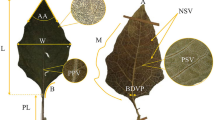Abstract
As a result of a taxonomic and phylogenetic study of Chamaecrista sect. Absus, we identified two new species of Chamaecrista from Brazil and Bolivia, which we designate here as C. oppositifolia and C. longistyla. Morphologically, C. oppositifolia resembles C. sincorana, while C. longistyla is similar to C. paraunana and C. brevicalyx. Description, illustration, diagnostic morphology, systematic position, phenology, distribution, images and preliminary conservation status are provided for both new species. Phylogenetic inference and morphology show that the two new species are clearly distinct and belong to C. sect. Absus, ser. Rigidulae (C. oppositifolia) and ser. Absoideae (C. longistyla).






Similar content being viewed by others
Literature cited
Bachman, S., J. Moat, A. W. Hill, J. de la Torre & B. Scott. 2011. Supporting Red List threat assessments with GeoCAT: geospatial conservation assessment tool. ZooKeys 150: 117–126.
BFG (The Brazil Flora Group). 2015. Growing knowledge: an overview of seed plant diversity in Brazil. Rodriguésia 66: 1085–1113.
Conceição, A. S., L. P. Queiroz, G. P. Lewis, M. J. G. Andrade, P. R. M. Almeida, A. S. Schnadelbach & C. Van de Berg. 2009. Phylogeny of Chamaecrista Moench (Leguminosae- Caesalpinioideae) based on nuclear and chloroplast DNA regions. Taxon 58: 1168–1180.
Cota, M. M. T., J. G. Rando & R. Mello-Silva. 2016. Chamaecrista petiolata (Leguminosae, Caesalpinioideae), new species from Diamantina Plateau, Minas Gerais, Brazil. Phytotaxa 267: 70–76.
Darriba, D., G. L. Taboada, R. Doallo & D. Posada. 2014. jModelTest 2.1.5:more models, new heuristics and parallel computing. Nature Methods 9: 772.
Doyle, J. J. & J. L. Doyle. 1987. A rapid DNA isolation method for small quantities of fresh tissues. Phytochemical Bulletin 19: 11–15.
Drummond, A. J., M. A. Suchard, D. Xie & A. Rambaut. 2012. Bayesian phylogenetics with BEAUti and the BEAST 1.7. Molecular Biology and Evolution 29: 1969–1973.
Felsenstein, J. 1985. Confidence limits on phylogenies: an approach using the bootstrap. Evolution 39: 783–791.
Hall, T. A. 1999. BioEdit: A user-friendly biological sequence alignment editor and analysis program forWindows 95/98/NT. Nucleic Acids Symposium Series 41: 95–98.
Irwin, H. S. & R. C. Barneby. 1978. Monographic studies in Cassia (Leguminosae-Caesalpinioideae). III. Sections Absus and Grimaldia. Memoirs of the New York Botanical Garden 30: 1–277.
Irwin, H. S. & R. C. Barneby. 1982. The American Cassiinae: a synoptical revision of Leguminosae tribe Cassieae subtribe Cassiinae in the New World. Memoirs of the New York Botanical Garden 35: 455–918.
IUCN. 2012. IUCN Red List categories and criteria: Version 3.1. Second edition. Gland, Switzerland and Cambridge, UK.
IUCN Standards and Petitions Subcommittee. 2017. Guidelines for using the IUCN Red List Categories and Criteria. Version 13. Downloadable from: http://www.iucnredlist.org/documents/RedListGuidelines.pdf.
Lanfear, R., B. Calcott, S. Y. Ho & S. Guindon. 2012. PartitionFinder: Combined selection of partitioning schemes and substitution models for phylogenetic analyses. Molecular Biology 29: 1695–1701.
LPWG (The Legume Phylogeny Working Group). 2017. A new subfamily classification of the Leguminosae based on a taxonomically comprehensive phylogeny. Taxon 66: 44–77.
Mendes, T. P., A. O. Souza & M. J. Silva. 2017. A new species hidden in the lowlands of Tocantins, Brazil: Chamaecrista tocantinensis (Fabaceae). Systematic Botany 42: 326–337.
QGIS (Quantum GIS Development Team). 2015. Quantum GIS Geographic Information System. Version 2.8.2.
Ronquist, F. & J. P. Huelsenbeck. 2003. MrBayes 3: Bayesian phylogenetic inference under mixed models. Bioinformatics 19: 1572–1574.
Silva, M. J. & A. O. Souza. 2014. A new species of the genus Chamaecrista (Leguminosae, Caesalpinioideae) from Chapada dos Veadeiros, Goiás, Brazil. Phytotaxa 174:181–186.
Silva, M. J. & A. O. Souza. 2015. A new species of Chamaecrista (Fabaceae, Caesalpinioideae, Cassieae) from the highlands of Goiás, Brazil. Systematic Botany 40:157–161.
Silva, M. J. & A. O. Souza & A. A. Alonso. 2017. Chamaecrista belladonna (Fabaceae, Caesalpinioideae, Cassieae), a new threatened endemic species from Goiás, Brazil. Brittonia 69: 544–552.
Souza, A. O. & M. J. Silva. 2015a. A new species of Chamaecrista (Leguminosae) from the Brazilian Central Plateau. Phytotaxa 204: 165–171.
Souza, A. O. & M. J. Silva. 2015b. What’s new in Chamaecrista (Fabaceae, Caesalpinioideae) from the Brazilian Cerrado? Phytotaxa 213: 253–262.
Souza, A. O. & M. J. Silva. 2018 Chamaecrista elata (Leguminosae, Caesalpinioideae), a new species from the highlands of Goiás, Brazil. Brittonia 70: 241–247.
Souza, A. O., M. J. Silva & A. A. Alonso. 2015. Novelties in Chamaecrista (Fabaceae, Caesalpinioideae) from Brazilian Savannah. Phytotaxa 239: 143–154.
Souza, A. O., G. P. Lewis, M. P. C. Telles & M. J. Silva. 2019. Phylogeny and divergence time estimation of Chamaecrista ser. Rigidulae (Leguminosae, Caesalpinioideae), Taxon 62: 1200–1219.
Sun, Y., D. Z. Skinner, G. H. Liang & S. H. Hulbert. 1994. Phylogenetic analysis of Sorghum and related taxa using internal transcribed spacers of nuclear ribosomal DNA. Theoretical and Applied Genetics 89: 26–32.
Swofford, D. L. 2003. PAUP*: phylogenetic analysis using parsimony (*and other methods), version 4.0. Sinauer, Sunderland, MA.
Taberlet, P., L. Gielly, G. Pautou & J. Bouvet. 1991. Universal primers for amplification of three non-coding regions of chloroplast DNA. Plant Molecular Biology 15: 1105–1109.
Tamura, K., G. Stecher, D. Peterson, A. Filipski & S. Kumar. 2013. MEGA6:Molecular Evolutionary Genetics Analysis version 6.0. Molecular Biology and Evolution 30: 2725–2729.
Thiers, B. 2018 [continuously updated]. Index Herbariorum: A global directory of public herbaria and associated staff. New York Botanical Garden’s Virtual Herbarium, Bronx, New York. Available from: sweetgum.nybg.org/ih/ (accessed: 23 July 2018).
Acknowledgments
We express our gratitude to the Coordenação de Aperfeiçoamento de Pessoal de Nível Superior (CAPES) for the grant to the first author, to Renato Galhardo for the illustrations, and to the staff of the HERBAN herbarium for assistance.
Author information
Authors and Affiliations
Corresponding author
Electronic supplementary material
ESM 1
(DOCX 21 kb)
Rights and permissions
About this article
Cite this article
de Souza, A.O., Matos, R.G. & da Silva, M.J. Two new species of Chamaecrista sect. Absus (Leguminosae, Casesalpinioideae) from Brazil and Bolivia with phylogenetic delimitation. Brittonia 71, 299–311 (2019). https://doi.org/10.1007/s12228-019-09583-y
Published:
Issue Date:
DOI: https://doi.org/10.1007/s12228-019-09583-y




